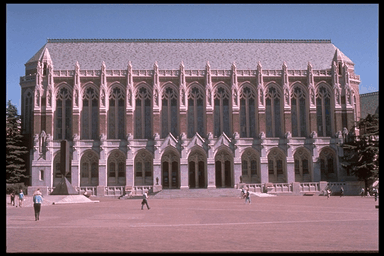CSE 510 Lab #1: The Use of Affordances
|
|
Design Problem StatementHow can automated library search systems best assist user's in selecting documents from a library's collection. The Library Search SystemIn nearly all cases, library users are expected to make their choices based on a query-based, text-only search system which returns relatively little information about particular titles. The Library Search Process
Where the Design Succeeds
Where the Design Fails
Some Evidence of the ProblemResearchers and scholars, whom one expects to be most familiar and comfortable with library search systems tend not to use these systems in their work. Multiple studies across disciplines have corroborated this point, finding minimal use of established info-retrieval mechanisms by scholars (Olaisen, 1984; Webb, 1986; Bjork & Turk, 2000). Why does one see such surprising results? Primarily due to the lack of both affordances and visibility in media objects within the library's search system. How the Design FailsIn a 1999 study of ~200 readers in non-directed searches for texts, it was found that "clues on the book itself", including physical size, shape, and texture - primarily visual and haptic 'affordances' - were the most important factors in determining how readers chose books (Ross, 1999). This points to the necessity of providing this type of information to library searchers; a point that has not been lost on book and media sellers within fields like E-commerce. Here, smart marketeers have realized the importance of such physical and visual clues and one is hard-pressed to find an E-commerce site that does not provide them. |
Why the Design FailsUpon examination, we can easily see how the wide variety of haptic and visual affordances employed by so many readers are handled in a typical library system. Not only are these visual(visibility) and physical(affordances) clues not included within the information presented in a typical search, but they are physically stripped away from library documents before they are even shelved, replacing crucial information with non-descript uniformity - usually in the form of thick cloth bindings. Additionally, in book or movie rental stores, one often finds desired tiles by acsidentally 'noticing them' on shelves near titles they were explicitly searching for. Again, in current library systems, this possibility is lost. An Alternative ScenarioWhile practices like those above are most likely motivated by the desire to protect library documents, there are certainly ways this may be achieved without destroying important portions of the object's information content. Instead, for example, imagine the following scenario: as each document is received by a library, it is scanned front and back, before being stripped of its covers and rebound. A simple addition to any such search system would be the display of such images beside the usual descriptive text. The user could then enlarge the image to obtain a visually satisfying view of the document's external properties. Although the haptic and physical affordances of the document may be still be lost, we have still preserved the tex and image based affordances one would typically use in choosing a book. |

